 W
WWater conservation includes all the policies, strategies and activities to sustainably manage the natural resource of fresh water, to protect the hydrosphere, and to meet the current and future human demand. Population, household size and growth and affluence all affect how much water is used. Factors such as climate change have increased pressures on natural water resources especially in manufacturing and agricultural irrigation. Many countries have already implemented policies aimed at water conservation, with much success.
 W
WArtificial turf is a surface of synthetic fibers made to look like natural grass. It is most often used in arenas for sports that were originally or are normally played on grass. However, it is now being used on residential lawns and commercial applications as well. The main reason is maintenance—artificial turf stands up to heavy use, such as in sports, and requires no irrigation or trimming. Domed, covered, and partially covered stadiums may require artificial turf because of the difficulty of getting grass enough sunlight to stay healthy. Artificial turf does have its downside, however: limited life, periodic cleaning requirements, petroleum use, toxic chemicals from infill, and heightened health and safety concerns.
 W
WAn automatic faucet or tap is a faucet equipped with a proximity sensor and mechanism that opens its valve to allow water to flow in response to the presence of a user's hands in close proximity. The faucet closes its valve again after a few seconds or when it no longer detects the presence of a user's hands.
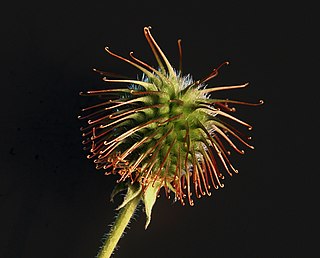 W
WBiomimetics or biomimicry is the emulation of the models, systems, and elements of nature for the purpose of solving complex human problems. The terms "biomimetics" and "biomimicry" are derived from Ancient Greek: βίος (bios), life, and μίμησις (mīmēsis), imitation, from μιμεῖσθαι (mīmeisthai), to imitate, from μῖμος (mimos), actor. A closely related field is bionics.
 W
WBioretention is the process in which contaminants and sedimentation are removed from stormwater runoff. Stormwater is collected into the treatment area which consists of a grass buffer strip, sand bed, ponding area, organic layer or mulch layer, planting soil, and plants. Runoff passes first over or through a sand bed, which slows the runoff's velocity, distributes it evenly along the length of the ponding area, which consists of a surface organic layer and/or groundcover and the underlying planting soil. The ponding area is graded, its center depressed. Water is ponded to a depth of 15 cm (5.9 in) and gradually infiltrates the bioretention area or is evapotranspired. The bioretention area is graded to divert excess runoff away from itself. Stored water in the bioretention area planting soil exfiltrates over a period of days into the underlying soils.
 W
WBioswales are channels designed to concentrate and convey stormwater runoff while removing debris and pollution. Bioswales can also be beneficial in recharging groundwater.
 W
WA check dam is a small, sometimes temporary, dam constructed across a swale, drainage ditch, or waterway to counteract erosion by reducing water flow velocity. Check dams themselves are not a type of new technology; rather, they are an ancient technique dating from the second century A.D. Check dams are typically, though not always, implemented in a system of several dams situated at regular intervals across the area of interest.
 W
WA cistern is a waterproof receptacle for holding liquids, usually water. Cisterns are often built to catch and store rainwater. Cisterns are distinguished from wells by their waterproof linings. Modern cisterns range in capacity from a few litres to thousands of cubic metres, effectively forming covered reservoirs.
 W
WA composting toilet is a type of dry toilet that treats human waste by a biological process called composting. This process leads to the decomposition of organic matter and turns human waste into compost-like material, but does not destroy all pathogens. Composting is carried out by microorganisms under controlled aerobic conditions. Most composting toilets use no water for flushing and are therefore called "dry toilets".
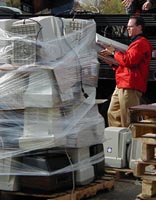 W
WComputer recycling, electronic recycling or e-waste recycling is the disassembly and separation of components and raw materials of waste electronics. Although the procedures of re-use, donation and repair are not strictly recycling, these are other common sustainable ways to dispose of IT waste.
 W
WConcrete recycling is the use of rubble from demolished concrete structures. Recycling is cheaper and more ecological than trucking rubble to a landfill. Crushed rubble can be used for road gravel, revetments, retaining walls, landscaping gravel, or raw material for new concrete. Large pieces can be used as bricks or slabs, or incorporated with new concrete into structures, a material called urbanite.
 W
WContour trenching is an agricultural technique that can be easily applied in arid sub-Sahara areas to allow for water, and soil conservation, and to increase agricultural production.
 W
WCotton recycling prevents unneeded wastage and can be a more sustainable alternative to disposal. Recycled cotton can come from secondhand clothing or from textile waste or leftovers which are then spun into new yarns and fabrics. There are some notable limitations of recycled cotton, including separation of materials that are cotton/polyester mix. There may also be limits to durability in using recycled cotton.
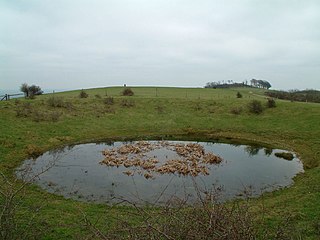 W
WA dew pond is an artificial pond usually sited on the top of a hill, intended for watering livestock. Dew ponds are used in areas where a natural supply of surface water may not be readily available. The name dew pond is first found in the Journal of the Royal Agricultural Society in 1865. Despite the name, their primary source of water is believed to be rainfall rather than dew or mist.
 W
WDrip irrigation is a type of micro-irrigation system that has the potential to save water and nutrients by allowing water to drip slowly to the roots of plants, either from above the soil surface or buried below the surface. The goal is to place water directly into the root zone and minimize evaporation. Drip irrigation systems distribute water through a network of valves, pipes, tubing, and emitters. Depending on how well designed, installed, maintained, and operated it is, a drip irrigation system can be more efficient than other types of irrigation systems, such as surface irrigation or sprinkler irrigation.
 W
WA dry toilet is a toilet that operates without flush water, unlike a flush toilet. The dry toilet may have a raised pedestal on which the user can sit, or a squat pan over which the user squats in the case of a squat toilet. In both cases, the excreta falls through a drop hole.
 W
WThe Environmental Quality Incentives Program (EQIP) is a United States government program designed to assist farmers in improving environmental quality, particularly water quality and soil conservation. Congress established the program in the 1996 farm bill to provide primarily cost-sharing assistance, but also technical and educational assistance, aimed at promoting production and environmental quality, and optimizing environmental benefits.
 W
WEvapotranspiration (ET) is the sum of evaporation and plant transpiration from the Earth's land and ocean surface to the atmosphere. Evaporation accounts for the movement of water to the air from sources such as the soil, canopy interception, and water bodies. Transpiration accounts for the movement of water within a plant and the subsequent loss of water as vapor through stomata in its leaves in vascular plants and phyllids in non-vascular plants. Evapotranspiration is an important part of the water cycle. An element that contributes to evapotranspiration can be called an evapotranspirator.
 W
WA gabion is a cage, cylinder or box filled with rocks, concrete, or sometimes sand and soil for use in civil engineering, road building, military applications and landscaping.
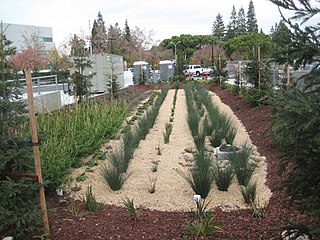 W
WGreen infrastructure is defined in the United States by section 502 of the Clean Water Act as the range of measures that use plant or soil systems, permeable surfaces, stormwater harvest and reuse, infiltrate or evapotranspirate stormwater and reduce flows to sewer systems or to surface waters. Green infrastructure encompasses various water management practices such as vegetated rooftops, absorbent gardens and other measures to capture, filter, and reduce stormwater. Green infrastructure prevents or reduces the amount of water that flows into storm drains and is proved as an important tool for cities with combined sewer overflows and nutrient problems. It provides many environmental, social, and economic benefits such as improved surface water quality, water conservation, and community safety. Green Infrastructure is a cost effective and resilient approach to managing stormwater. While gray stormwater infrastructure is designed to move stormwater away from the built environment, green infrastructure treats the water at the source.
 W
WGrey water or sullage is all the wastewater generated in households or office buildings from streams without fecal contamination, i.e. all streams except for the wastewater from toilets. Sources of grey water include sinks, showers, baths, washing machines or dishwashers. As grey water contains fewer pathogens than domestic wastewater, it is generally safer to handle and easier to treat and reuse onsite for toilet flushing, landscape or crop irrigation, and other non-potable uses.
 W
WThe Groundwater Ambient Monitoring and Assessment Program (GAMA) is an all-inclusive monitoring program for groundwater that was implemented in 2000 in California, United States. It was created by the California State Water Resources Control Board as an improvement from groundwater programs that were already in place. GAMA monitors various aspects in groundwater such as the water quality and allotment total through research projects conducted by multiple agencies both statewide and locally sourced. GAMA wants to improve public awareness for groundwater resources as well as improve monitoring on groundwater research across the state to assess potential hazards from this resource.
 W
WGroundwater recharge or deep drainage or deep percolation is a hydrologic process, where water moves downward from surface water to groundwater. Recharge is the primary method through which water enters an aquifer. This process usually occurs in the vadose zone below plant roots and, is often expressed as a flux to the water table surface. Groundwater recharge also encompasses water moving away from the water table farther into the saturated zone. Recharge occurs both naturally and through anthropogenic processes, where rainwater and or reclaimed water is routed to the subsurface.
 W
WHand dryer is an electric machine which makes use of heating element and an air blower to dry the hands after hand washing. It is commonly used in public toilets as a cost-effective alternative to paper towels.
 W
WIce Stupa is a form of glacier grafting technique that creates artificial glaciers, used for storing winter water in the form of conical shaped ice heaps. During summer, when water is scarce, the Ice Stupa melts to increase water supply for crops. Ice Stupa was invented by Sonam Wangchuk in Ladakh (India) and the project is undertaken by the NGO Students' Educational and Cultural Movement of Ladakh. Launched in October 2013, the test project started in January 2014 under the project name The Ice Stupa project. On 15 November 2016, Sonam Wangchuk was awarded the Rolex Awards for Enterprise for his work on Ice Stupa.
 W
WKeyline design is a landscaping technique of maximizing the beneficial use of the water resources of a tract of land. The "keyline" denominates a specific topographic feature related to the natural flow of water on the tract. Keyline design is a system of principles and techniques of developing rural and urban landscapes to optimize use of their water resources.
 W
WLiving Machine is a form of ecological sewage treatment. Similar to Solar Aquatics Systems, the latest generation of the technology is based on fixed-film ecology.
 W
WMicro-irrigation, also called localized irrigation, low volume irrigation, low-flow irrigation, or trickle irrigation, is an irrigation method with lower pressure and flow than a traditional sprinkler system. Low volume irrigation is used in agriculture for row crops, orchards, and vineyards. It is also used in horticulture in wholesale nurseries, in landscaping for civic, commercial, and private landscapes and gardens, and in the science and practice of restoration ecology and environmental remediation.
 W
WNir Oz is a kibbutz in southern Israel. It is located in the northwestern Negev desert between Magen and Nirim, and covers 20,000 dunams. Nir Oz is under the jurisdiction of Eshkol Regional Council. In 2019 it had a population of 387.
 W
WThe recycling of paper is the process by which waste paper is turned into new paper products. It has a number of important benefits: It saves waste paper from occupying homes of people and producing methane as it breaks down. Because paper fibre contains carbon, recycling keeps the carbon locked up for longer and out of the atmosphere. Around two-thirds of all paper products in the US are now recovered and recycled, although it does not all become new paper. After repeated processing the fibres become too short for the production of new paper - this is why virgin fibre will be added to the pulp recipe.
 W
WPermeable paving is a method of paving vehicle and pedestrian pathways to enable infiltration of stormwater runoff. Permeable pavement surfaces typically include pervious concrete, porous asphalt, paving stones and interlocking pavers. Unlike traditional impervious paving materials, permeable paving systems allow stormwater to percolate and infiltrate through the pavement and into the aggregate layers and/or soil below. In addition to reducing surface runoff, permeable paving systems can trap suspended solids, thereby filtering pollutants from stormwater. The goal is to control stormwater at the source, reduce runoff and improve water quality by filtering pollutants in the subsurface layers.
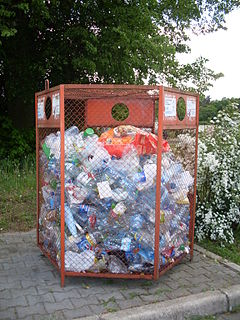 W
WPlastic recycling is the process of recovering scrap or waste plastic and reprocessing the material into useful products. Compared with the lucrative recycling of metal, and similar to the low value of glass recycling, plastic polymers recycling is often more challenging because of low density and low value. There are also numerous technical hurdles to overcome when recycling plastic.
 W
WPrecious Plastic is an open hardware plastic recycling project and is a type of open source digital commons project. The project was started in 2013 by Dave Hakkens and is now in its fourth iteration. It relies on a series of machines and tools which grind, melt, and inject recycled plastic, allowing for the creation of new products out of recycled plastic on a small scale.
 W
WPumped-storage hydroelectricity (PSH), or pumped hydroelectric energy storage (PHES), is a type of hydroelectric energy storage used by electric power systems for load balancing. The method stores energy in the form of gravitational potential energy of water, pumped from a lower elevation reservoir to a higher elevation. Low-cost surplus off-peak electric power is typically used to run the pumps. During periods of high electrical demand, the stored water is released through turbines to produce electric power. Although the losses of the pumping process make the plant a net consumer of energy overall, the system increases revenue by selling more electricity during periods of peak demand, when electricity prices are highest. If the upper lake collects significant rainfall or is fed by a river then the plant may be a net energy producer in the manner of a traditional hydroelectric plant.
 W
WRain gardens, also called bioretention facilities, are one of a variety of practices designed to treat polluted stormwater runoff. Rain gardens are designed landscape sites that reduce the flow rate, total quantity, and pollutant load of runoff from impervious urban areas like roofs, driveways, walkways,and parking lots, and compacted lawn areas. Rain gardens rely on plants and natural or engineered soil medium to retain stormwater and increase the lag time of infiltration, while remediating and filtering pollutants carried by urban runoff. Rain gardens provide a method to reuse and optimize any rain that falls, reducing or avoiding the need for additional irrigation. A benefit of planting rain gardens is the consequential decrease in ambient air and water temperature, a mitigation that is especially effective in urban areas containing an abundance of impervious surfaces that absorb heat in a phenomenon known as the heat-island effect.
 W
WRainwater harvesting (RWH) is the collection and storage of rain, rather than allowing it to run off. Rainwater is collected from a roof-like surface and redirected to a tank, cistern, deep pit, aquifer, or a reservoir with percolation. Dew and fog can also be collected with nets or other tools. Rainwater harvesting differs from stormwater harvesting as the runoff is collected from roofs, rather than creeks, drains, roads, or any other land surfaces. Its uses include watering gardens, livestock, irrigation, domestic use with proper treatment, and domestic heating. The harvested water can also be committed to longer-term storage or groundwater recharge.
 W
WReclaimed or recycled water is the process of converting wastewater into water that can be reused for other purposes. Reuse may include irrigation of gardens and agricultural fields or replenishing surface water and groundwater. Reused water may also be directed toward fulfilling certain needs in residences, businesses, and industry, and could even be treated to reach drinking water standards. This last option is called either "direct potable reuse" or "indirect potable" reuse, depending on the approach used.
 W
WRecycling is the process of converting waste materials into new materials and objects. The recovery of energy from waste materials is often included in this concept. The recyclability of a material depends on its ability to reacquire the properties it had in its virgin or original state. It is an alternative to "conventional" waste disposal that can save material and help lower greenhouse gas emissions. Recycling can prevent the waste of potentially useful materials and reduce the consumption of fresh raw materials, thereby reducing: energy usage, air pollution, and water pollution.
 W
WA road verge is a strip of grass or plants, and sometimes also trees, located between a roadway (carriageway) and a sidewalk (pavement). Verges are known by dozens of other names, often quite regional; see Terminology, below.
 W
WSand dams are a simple, low-cost and low-maintenance, replicable rainwater harvesting technology. They provide a clean, local water supply for domestic and farming use and are suited to semi-arid areas of the world.
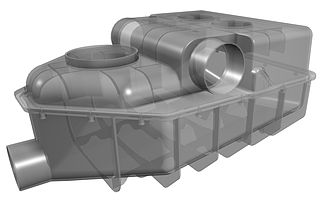 W
WA sewer dosing unit (SDU) is a plumbing device to allow effective sewage disposal with low liquid-flow rates. With a global emphasis on water saving, many new buildings and renovations are seeing the installation of water saving fixtures such as low flow shower heads and low flush toilets. With the decrease in wastewater flows problems are arising from waste solids not being carried completely to the main sewers, often causing blockages.
 W
WSoil moisture sensors measure the volumetric water content in soil. Since the direct gravimetric measurement of free soil moisture requires removing, drying, and weighing of a sample, soil moisture sensors measure the volumetric water content indirectly by using some other property of the soil, such as electrical resistance, dielectric constant, or interaction with neutrons, as a proxy for the moisture content.
 W
WStormwater harvesting or stormwater reuse is the collection, accumulation, treatment or purification, and storage of stormwater for its eventual reuse. While rainwater harvesting collects precipitation primarily from rooftops, stormwater harvesting deals with collection of runoff from creeks, gullies, ephemeral streams, and other ground conveyances. It can also include catchment areas from developed surfaces, such as roads or parking lots, or other urban environments such as parks, gardens and playing fields.
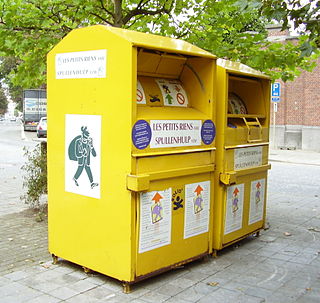 W
WTextile recycling is the process of recovering fiber, yarn or fabric and reprocessing the textile material into useful products. Textile waste products are gathered from different sources and are then sorted and processed depending on their condition, composition, and resale value. The end result of this processing can vary, from the production of energy and chemicals to new articles of clothing.
 W
WVehicle recycling is the dismantling of vehicles for spare parts. At the end of their useful life, vehicles have value as a source of spare parts and this has created a vehicle dismantling industry. The industry has various names for its business outlets including wrecking yard, auto dismantling yard, car spare parts supplier, and recently, auto or vehicle recycling. Vehicle recycling has always occurred to some degree but in recent years manufacturers have become involved in the process. A car crusher is often used to reduce the size of the scrapped vehicle for transportation to a steel mill.
 W
WResidential water use includes all indoor and outdoor uses of drinking quality water at single-family and multifamily dwellings. These uses include a number of defined purposes such as flushing toilets, washing clothes and dishes, showering and bathing, drinking, food preparation, watering lawns and gardens, and maintaining swimming pools. Some of these end uses are detectable while others are more difficult to gauge.
 W
WWater efficiency is reducing water wastage by measuring the amount of water required for a particular purpose and the amount of water used or delivered. Water efficiency differs from water conservation in that it focuses on reducing waste, not restricting use. Solutions for water efficiency focus not only on reducing the amount of potable water used, but also on reducing the use of non-potable water where appropriate. It also emphasises the influence consumers can have in water efficiency by making small behavioural changes to reduce water wastage and by choosing more water efficient products.
 W
WA water filter removes impurities by lowering contamination of water using a fine physical barrier, a chemical process, or a biological process. Filters cleanse water to different extents for purposes such as providing agricultural irrigation, accessible drinking water, public and private aquariums, and the safe use of ponds and swimming pools.
 W
WWater in Africa is an important issue encompassing the sources, distribution and economic uses of the water resources on the continent. Overall, Africa has about 9% of the world's fresh water resources and 16% of the world's population. There are about 17 rivers in the African continent.Among these rivers are the Congo, Nile, Zambezi, Niger and Lake Victoria, considered the world’s second largest river. Yet the continent is the second driest in the world, with millions of Africans still suffering from water shortages throughout the year.
 W
WWater resource policy encompasses the policy-making processes that affect the collection, preparation, use and disposal of water to support human uses and protect environmental quality. Water policy addresses provision, use, disposal and sustainability decisions. Provision includes identification, access, preparation for use and distribution. Uses include direct human consumption, agriculture, industry and ecosystem protection. Policy must set the rules for how water is allocated to the different uses. Disposal involves wastewater treatment and stormwater/flood management. Sustainability addresses issues such as aquifer depletion, reservoir management and mineral buildup.
 W
WLevels of water scarcity in Africa are predicted to reach dangerously high levels by 2025. It is estimated that about two-third of the world's population may suffer from fresh water shortage by 2025. Although, the earth is made up of 70 percent water, only 3 percent of this water is actually fresh water, which is suitable for consumption. Water scarcity is the lack of fresh water resources to meet the standard water demand. Water scarcity can be caused by droughts, lack of rainfall, or human and animal pollutions. Its main causes in Africa are physical and economic scarcity, rapid population growth, and climate change.
A water tank is a container for storing water.
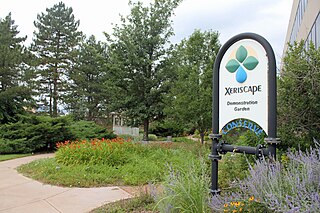 W
WXeriscaping is the process of landscaping or gardening that reduces or eliminates the need for supplemental water from irrigation. It is promoted in regions that do not have accessible, plentiful or reliable supplies of fresh water and is gaining acceptance in other regions as access to irrigation water is becoming limited. Xeriscaping may be an alternative to various types of traditional gardening.